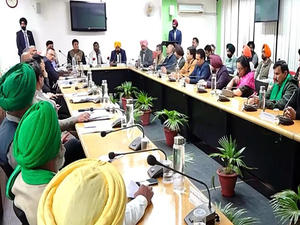Modi govt’s progressive efforts for Punjab’s farmers and ecology
By IANS | Published: February 22, 2024 11:47 AM2024-02-22T11:47:44+5:302024-02-22T11:50:05+5:30
New Delhi, Feb 22 During the talks between the Centre and the farm unions from Punjab on February ...

Modi govt’s progressive efforts for Punjab’s farmers and ecology
New Delhi, Feb 22 During the talks between the Centre and the farm unions from Punjab on February 18, the Narendra Modi government proposed a unique solution where it was willing to enter into an agreement with the farmers of Punjab on five crops -- cotton, maize, tur, urad, masur.
The idea was to help farmers diversify away from wheat and paddy, both water-intensive crops, and to cushion and monetarily secure their transition for the next five years. The agreement was to be done through government agencies (CCI, NAFED, etc.). There was no upper limit on the quantum of crops that would have been procured.
From an ecological perspective, this was ideal for Punjab, where the groundwater levels have alarmingly depleted. Of the 138 assessed blocks in Punjab, stated in the Dynamic Groundwater Resources Assessment of India - 2017 report, 109 are over-exploited, two as critical, five as semi-critical, and only 22 as safe.
The total annual groundwater recharge of the state was assessed as 23.93 bcm (billion cubic metres), annual extractable groundwater resource was 21.59 bcm. Still, the annual groundwater extraction was at 35.78 bcm, putting the extraction at 166 per cent, the highest for any state in India. Even for Rajasthan, it’s less than 140 per cent.
For a small farmer, the cost of extracting groundwater has increased in the last few years, and therefore, by moving away to crops that were not water-intensive, the input costs would have reduced.
Punjab’s majority area is under wheat and paddy cultivation (85 per cent in 2020-21). Therefore an ecosystem (market, buyers, logistics, input supplies, etc.) for cotton, pulses, and maize is not as significant, therefore warranting government support for the farmers, as they entered into a new phase of agriculture.
In terms of area under cultivation, Maize makes up for 1.5 per cent, Cotton is 3.2 per cent, and pulses merely 0.4 per cent. For farmers, moving towards these crops would have unlocked new markets and buyers, especially in the private sector, thus allowing them more options to sell their produce, even to the private players, at will.
Farm unions, majorly made up of brokers, or 'arhtiyas', as they are locally known, are also prioritising their hefty commissions that they earn from the trade of wheat and paddy at APMC mandis. More than the price for the farmers, it is about securing the commission of the middlemen, at the cost of Punjab’s hardworking farmers and ecology.
Disclaimer: This post has been auto-published from an agency feed without any modifications to the text and has not been reviewed by an editor
Open in app